Serving 200 students in grades Kindergarten-5, Hunnewell ranks in the top 5% of all schools in Massachusetts for overall test scores (math proficiency is top 5%, and reading proficiency is top 5%).
The percentage of students achieving proficiency in math is 80-84% (which is higher than the Massachusetts state average of 41%). The percentage of students achieving proficiency in reading/language arts is 75-79% (which is higher than the Massachusetts state average of 44%).
The student:teacher ratio of 10:1 is lower than the Massachusetts state level of 12:1.
Minority enrollment is 20% of the student body (majority Asian and Hispanic), which is lower than the Massachusetts state average of 47% (majority Hispanic).
Quick Stats (2025)
- Grades: Kindergarten-5
- Enrollment: 200 students
- Student:Teacher Ratio: 10:1
- Minority Enrollment: 20%
- Overall Testing Rank: Top 5% in MA
- Math Proficiency: 80-84% (Top 5%)
- Reading Proficiency: 75-79% (Top 5%)
- Science Proficiency: 80-89% (Top 1%)
- Source: National Center for Education Statistics (NCES), MA Dept. of Education
Top Rankings
Hunnewell ranks among the top 20% of public schools in Massachusetts for:
Category
Attribute
Overall Rank
Math Proficiency
Reading/Language Arts Proficiency
Science Proficiency
Community Size
School Overview
Hunnewell's student population of 200 students has declined by 23% over five school years.
The teacher population of 21 teachers has grown by 16% over five school years.
Grades Offered
Grades Kindergarten-5
(offers virtual instruction)
(offers virtual instruction)
Total Students
200 students
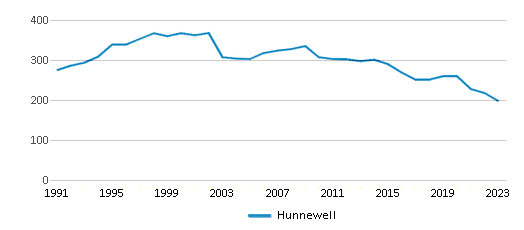
Gender %
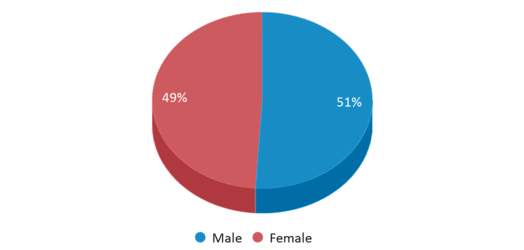
Total Classroom Teachers
21 teachers
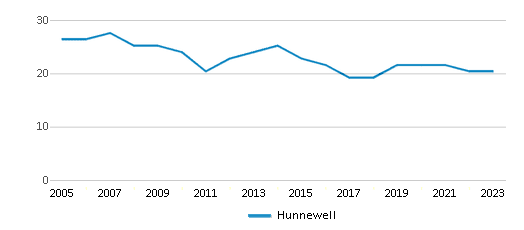
Students by Grade
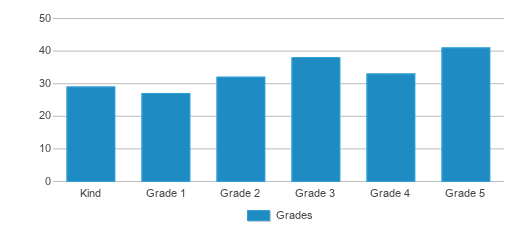
School Rankings
Hunnewell ranks within the top 5% of all 1,631 schools in Massachusetts (based off of combined math and reading proficiency testing data).
The diversity score of Hunnewell is 0.35, which is less than the diversity score at state average of 0.65. The school's diversity has stayed relatively flat over five school years.
Overall Testing Rank
#31 out of 1631 schools
(Top 5%)
(Top 5%)
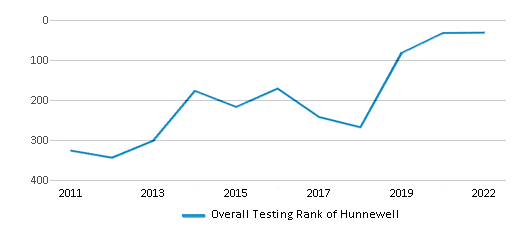
Math Test Scores (% Proficient)
80-84%
41%
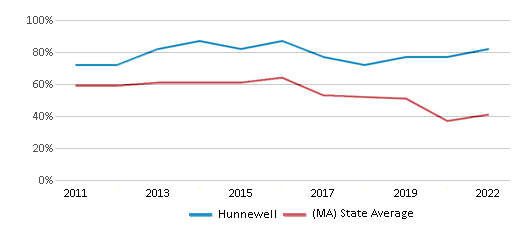
Reading/Language Arts Test Scores (% Proficient)
75-79%
44%
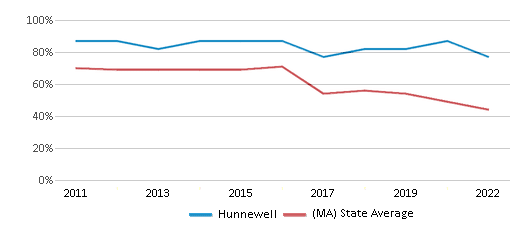
Science Test Scores (% Proficient)
80-89%
44%
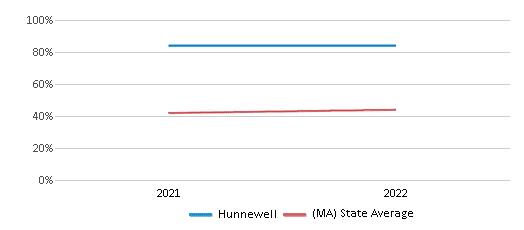
Student : Teacher Ratio
10:1
12:1
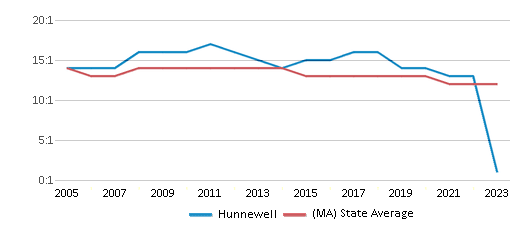
American Indian
n/a
n/a
Asian
7%
7%
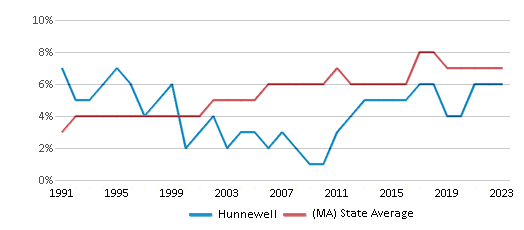
Hispanic
6%
25%
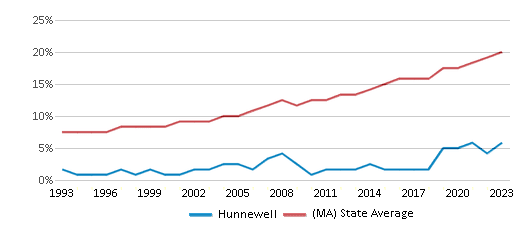
Black
2%
10%
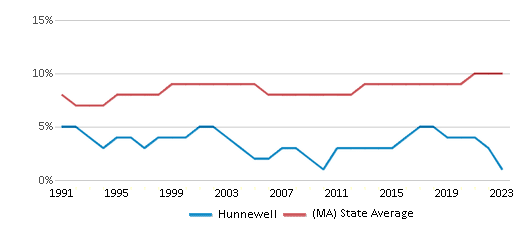
White
80%
53%
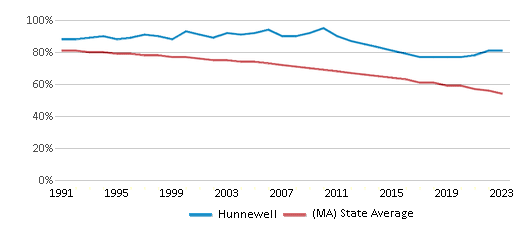
Hawaiian
n/a
n/a
Two or more races
5%
5%
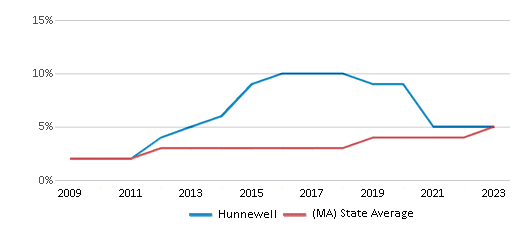
All Ethnic Groups
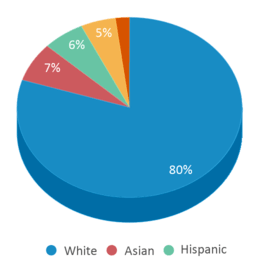
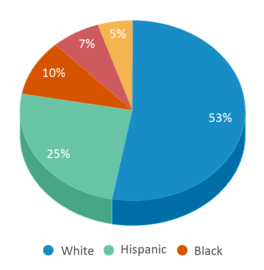
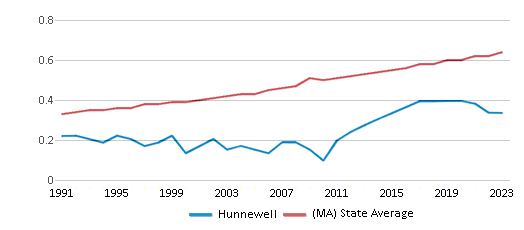
Participates in the National School Lunch Program (NSLP)
Yes
Eligible for Free Lunch
3%
35%
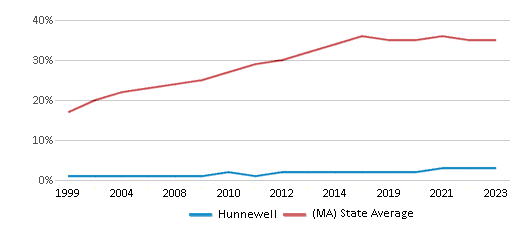
Eligible for Reduced Lunch
2%
4%
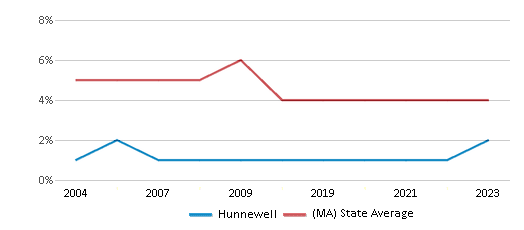
School Statewide Testing
School District Name
Source: National Center for Education Statistics (NCES), MA Dept. of Education
Profile last updated: 02/09/2025
Frequently Asked Questions
What is Hunnewell's ranking?
Hunnewell is ranked #31 out of 1,631 schools, which ranks it among the top 5% of public schools in Massachusetts.
What schools are Hunnewell often compared to?
Hunnewellis often viewed alongside schools like Sprague Elementary School, John D Hardy by visitors of our site.
What percent of students have achieved state testing proficiency in math and reading?
80-84% of students have achieved math proficiency (compared to the 41% MA state average), while 75-79% of students have achieved reading proficiency (compared to the 44% MA state average).
How many students attend Hunnewell?
200 students attend Hunnewell.
What is the racial composition of the student body?
80% of Hunnewell students are White, 7% of students are Asian, 6% of students are Hispanic, 5% of students are Two or more races, and 2% of students are Black.
What is the student:teacher ratio of Hunnewell?
Hunnewell has a student ration of 10:1, which is lower than the Massachusetts state average of 12:1.
What grades does Hunnewell offer ?
Hunnewell offers enrollment in grades Kindergarten-5 (offers virtual instruction).
What school district is Hunnewell part of?
Hunnewell is part of Wellesley School District.
School Reviews
2 2/25/2011
Is it possible to give zero stars?
Perhaps the other reviewers expectations were low but ours were actually pretty simple: treat our daughter with respect, treat us with respect and provide an environment in which she could learn to love learning.
Instead, her kindergarten class was a good portrait of what happens when a teacher stays in one place for wayyyy too long. (in this case 18 years).
Examples:
It was clear from the start that the teacher played favorites and if a child wasn't her favorite whatever was going wrong in the classroom was the fault of the child.
The attention to individuals was poor. The way the classroom was run was rigid with no flexibility for individuals.
While the students were supposedly learning to read, after my daughter moved to another school we figured out that she actually never learned - she is good at mimicking and that's how she was getting by.
Finally, the teacher, whom we were trusting to teach the basics of reading and writing to our child, was a poor speller. I started to feel sorry for her - however remembered she had access to spellcheck..
I have always been a strong advocate of public education. This experience made me seriously question why we fund what we fund.
Review Hunnewell. Reviews should be a few sentences in length. Please include any comments on:
- Quality of academic programs, teachers, and facilities
- Availability of music, art, sports and other extracurricular activities
Recent Articles

What Is A Charter School?
Explore the world of charter schools in this comprehensive guide. Learn about their history, how they operate, and the pros and cons of this educational innovation. Discover key facts about charter schools, including admission policies, demographics, and funding, as well as what to look for when considering a charter school for your child.

10 Reasons Why High School Sports Benefit Students
Discover the 10 compelling reasons why high school sports are beneficial for students. This comprehensive article explores how athletics enhance academic performance, foster personal growth, and develop crucial life skills. From improved fitness and time management to leadership development and community representation, learn why participating in high school sports can be a game-changer for students' overall success and well-being.

February 05, 2025
Understanding the U.S. Department of Education: Structure, Impact, and EvolutionWe explore how the Department of Education shapes American education, from its cabinet-level leadership to its impact on millions of students, written for general audiences seeking clarity on this vital institution.









